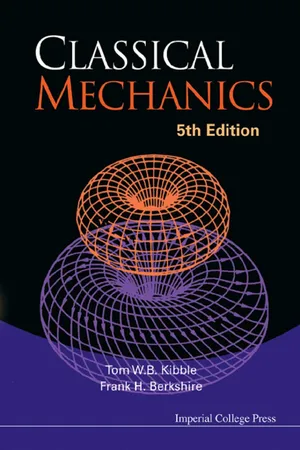Physics
Inertia Tensor
The inertia tensor is a mathematical representation of an object's resistance to changes in its rotational motion. It is a 3x3 matrix that describes how an object's mass is distributed around its center of mass. The inertia tensor is used in physics to calculate an object's moment of inertia and its rotational dynamics.
Written by Perlego with AI-assistance
Related key terms
Related key terms
1 of 4
Related key terms
1 of 3
3 Key excerpts on "Inertia Tensor"
- eBook - ePub
- Michael M. Mansfield, Colm O'Sullivan(Authors)
- 2020(Publication Date)
- Wiley(Publisher)
Chapter 3 we noted that mass represents a measure of how a body responds to an applied force, in the sense that it proves more difficult to give a large mass a translational acceleration than it is to give a small mass the same acceleration. In the same sense moment of inertia represents a measure of how a rigid body responds to an applied torque; for example, it requires a larger torque to produce the same angular acceleration in a wheel of large radius than in a wheel of the same mass but of smaller radius.The SI unit for moment of inertia iskg m2.For problems based on the material presented in this section visit up.ucc.ie/7/ and follow the link to the problems.7.7 Calculation of moments of inertia: the parallel axis theorem
So far we have treated a rigid body as an assemblage of discrete particles. Alternatively we may wish to consider a rigid body as a continuous distribution of matter, in which case the body may be thought of as divided into a very large number of infinitesimal mass elements (The moment of inertia about a symmetry axis of a body which has a relatively simple geometrical shape can be determined without undue difficulty as demonstrated by the following examples.Δmin Figure 7.14 is one such element). The summations in Equations (7.10) and (7.11) are then replaced by integrals and the moment of inertia can be calculated by integrating over the whole body, that is , where r is the perpendicular distance from the element Δm to the axis. This is an example of a volume integral (Appendix A.12.4 ).For a continuous distribution of matter in a rigid body, the body may be thought of as comprising a very large number of mass elements ΔmFigure 7.14 - eBook - ePub
- Tom W B Kibble, Frank H Berkshire(Authors)
- 2004(Publication Date)
- ICP(Publisher)
3 along these axes. Then, if we writethe components of J in these three directions will be obtained by multiplying the components of ω by the appropriate moments of inertia, as in (9.18). Thus we obtainThe three diagonal elements of the Inertia Tensor, I1 , I2 , I3 are called principal moments of inertia. We shall always use a single subscript for the principal moments, to distinguish them from moments of inertia about arbitrary axes.It is important to realize that the principal axes are fixed in the body, not in space, and therefore rotate with it. It is often convenient to use these axes to define our frame of reference, particularly since the principal moments II , I2 , I3 are constants. This is, however, a rotating frame, not an inertial one.The kinetic energy may also be expressed in terms of the angular velocity and the Inertia Tensor. We haveby a standard formula of vector algebra (see Appendix A , Problem 7). Comparing with (9.16), we see that(Equations (9.5) and (9.8) provide a special case of this general result.) Thus from (9.19) and (9.20), we findThese equations for rotational motion may be compared with the corresponding ones for translational motion with velocity v, namely T = . The principal difference is that the mass, unlike the Inertia Tensor, has no directional properties, so that the coefficients of and v2zare all equal.Symmetric bodiesThe term symmetric applied to a rigid body has a special, technical significance. It means that two of the principal moments of inertia coincide, say I1 = I2 . This is true in particular if the third axis e3 is a symmetry axis of appropriate type. It may be an axis of cylindrical symmetry — for example, the axis of a spheroid or a circular cylinder or cone. More generally, I1 = I2 if e3 is an axis of more than two-fold rotational symmetry — for example the axis of an equilateral triangular prism, or a square pyramid. (In the case of the prism, this is not entirely obvious. It follows from the fact that one cannot find a pair of perpendicular axes e1 and e2 - eBook - ePub
Classical Mechanics
A Computational Approach with Examples Using Mathematica and Python
- Christopher W. Kulp, Vasilis Pagonis(Authors)
- 2020(Publication Date)
- CRC Press(Publisher)
θ The complete Inertia Tensor is. then: I = [ I x x I x y I x z I y x I y y I y z I z x I z y I z z ] = m R 2 [ sin 2 ϕ sin 2 θ sin 2 ϕ sin θ cos θ − sin ϕ cos ϕ cos θ − sin 2 ϕ sin θ cos θ sin 2 ϕ cos 2[--=PL. GO-SEPARATOR=--] θ − sin ϕ cos ϕ sin θ − sin ϕ cos ϕ cos θ − sin ϕ cos ϕ sin θ sin 2 ϕ − cos 2 ϕ ]. The angular momentum vector can now be found by multiplying this matrix I with the angular momentum matrix ω = (0, 0, ω). ℓ = I ω After the matrix multiplication and using the trig identities cos 2 ϕ − sin 2 ϕ = cos (2 ϕ) and 2cos ϕ sin ϕ = sin (2 ϕ), we. obtain: ℓ x = − m R 2 ω sin (2 ϕ) cos (ω t) ℓ y = − m R 2 ω sin (2 ϕ) sin (ω t) ℓ z = − m R 2 ω cos (2 ϕ) The physical interpretation of these equations is that as the mass m rotates around the z -axis at the fixed angle ϕ, the angular momentum vector ℓ rotates around the z -axis also, but with a different angle equal to 2 ϕ. The z -component of the angular momentum vector stays constant in time, and is equal to ℓ z = − mR 2 ω cos (2 ϕ). If we are dealing with a continuous uniform distribution of particles instead of a collection of discrete masses m i, the summations in the above equations become integrals over the continuous variables (x, y, z), and the density of the material ρ (x, y, z) must be included inside the integrals. For solids in three dimensions, the components of the Inertia Tensor become: Inertia Tensor for a Continuous Mass. Distribution I x x = ∭ V (y 2 + z 2) ρ d x d y d z I y y = ∭ V (x 2 + z 2) ρ d x d y d z I z z = ∭ V (x 2 + y 2) ρ d x d y d z } (11.3.13) I x y = − ∭ V x y ρ d x d y d z I x z[--=PLGO-SEPARATO
Index pages curate the most relevant extracts from our library of academic textbooks. They’ve been created using an in-house natural language model (NLM), each adding context and meaning to key research topics.
Explore more topic indexes
Explore more topic indexes
1 of 6
Explore more topic indexes
1 of 4


